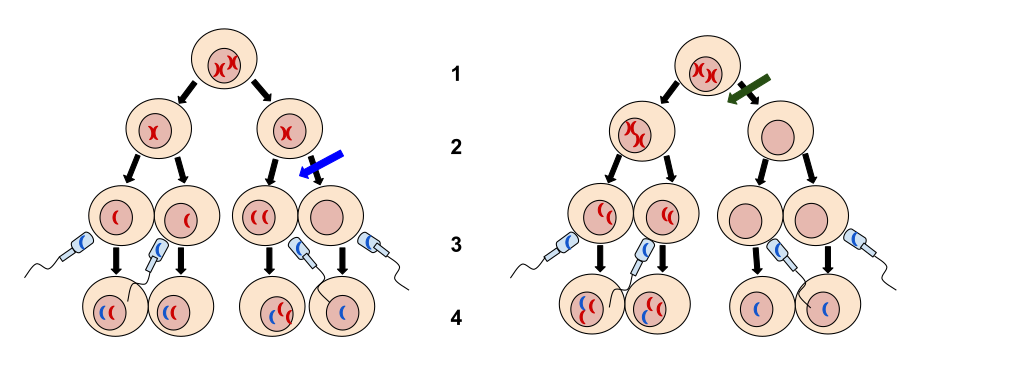Changes in ploidy due to mis-segregation of chromosomes
Improper meiosis or mitosis can result in cells with abnormal chromosome numbers. These are genetic mutations that affect entire chromosomes and therefore affect many genes. They can have a profound effect on the phenotype of a cell or of an organism.
If an error in chromosome number happens during meiosis, it will result in a germline mutation in a gamete. The mutation will be present in every cell of an offspring produced from that gamete. If an error in chromosome number happens during mitosis, it will result in a somatic mutation. Only the mitotic daughter cell – and its daughter cells – will be affected. This results in an organism with a mosaic genome: some cells will have a different genome than others. Somatic mutations cannot be passed to offspring through sexual reproduction, since meiocytes would not have the mutation.
Aneuploidy
Aneuploidy results when an extra chromosome or part of a chromosome is gained or lost from the cell. For example, monosomy describes a genome that only has one copy of one of the chromosomes. Trisomy means there are three copies of one of the chromosomes. A partial aneuploidy affects only part of a chromosome, with an extra (or missing) part of a chromosome.
Down syndrome, or Trisomy 21, is an example of an aneuploidy in humans, occurring in about 1/700 births. Sex chromosome aneuploidies also occur relatively often in the human population: as many as 1/500 people may have a sex chromosome aneuploidy. Other germline aneuploidies are more uncommon in humans: most result in embryonic death early in development. This is likely connected to the number of genes that are unbalanced by the extra or missing chromosome. Chromosome 21 is the smallest number of human chromosomes, and thus has the fewest number of genes impacted, making trisomy-21 less lethal than other trisomies that impact more genes.
Aneuploidies can result from nondisjunction during either mitosis or meiosis: the failure of either chromatids or chromosome pairs to separate before cytokinesis. Nondisjunction seems to happen more frequently with age in humans.
Figure 14 shows examples of nondisjunction in meiosis I (right) and meiosis II (left). Nondisjunction will always result in one daughter cell having an extra copy of a chromosome, and the other a missing one. It can happen in oogenesis or spermatogenesis, and if the gamete forms a zygote, the resulting offspring will have a change in chromosome number in every cell of their body.

If nondisjunction happens during mitosis, it will result in a somatic mutation. A somatic mutation affects the cell and any mitotic daughter cells, making the individual mosaic for the mutation, but it will not be passed to offspring unless it specifically affects the reproductive cells. As an example in humans, some people have mosaic Down syndrome: some, but not all, of their cells have an extra copy of chromosome 21. This can happen through mis-segregation during mitosis early in development. All subsequent mitoses will produce daughter cells with an extra chromosome. Mosaic Down syndrome can also occur if nondisjunction in meiosis results in an embryo with trisomy 21, and during subsequent mitosis one of the cells of the embryo loses the extra copy of chromosome 21.
Test Your Understanding
Polyploidy
An extra copy of one chromosome (or part of a chromosome) is an aneuploidy, but polyploidy results from the addition of an entire copy of the genome. Remember that cells with two copies of the genome are diploid. Cells could lose a copy of the genome and become haploid, or they can gain additional copies of the chromosomes.
Polyploidy might result when a cell undergoes replication but fails to undergo cytokinesis in mitosis, or through a failure of meiosis that does not reduce chromosome number. This can happen through a number of mechanisms, including a lack of cytokinesis, misalignment of spindle poles, or an atypical meiosis that skips either meiosis I or meiosis II[1].

Although aneuploidies typically cause reduced viability, in some species, especially plants, polyploidy is possible. This is likely because of gene balance: a biological pathway depends on having the correct ratios of interacting genes – too many or too few of interacting partners will affect function. This is kind of like having too many chocolate chips and not enough cookie dough to hold them together. But having a whole extra set can be better tolerated (you can double a recipe just fine).
We see this in a lot of cultivated plants. For example, most commercially available strawberries are octoploid, and some wheat strains are hexaploid.
Geneticists need a way to distinguish between the genomes of somatic cells and gametes, even in organisms with greater ploidy. Such organisms still make gametes with half as many copies of the genome. For example, octoploid strawberries produce tetraploid gametes, and hexaploid wheat strains produce triploid gametes.
So here’s where notation can get a little confusing: Polyploids are described using the letter “X” to indicate ploidy. And “n” indicates the number of chromosomes in a gamete. A somatic cell is always described as 2n, and a gamete = n.
Humans (diploid) are 2n= 2x = 46, since somatic cells have two copies of each chromosome. Octoploid strawberries are 2n = 8x = 56, and n = 4x = 28, with 8 copies of the genome in somatic cells and 4 copies of the genome in gametes.
Test Your Understanding
Media Attributions
- The-cell-cycle-194×300-1
- De Storme, N. & Geelen, D. Sexual polyploidization in plants – cytological mechanisms and molecular regulation. New Phytol. 198, 670–684 (2013). ↵

